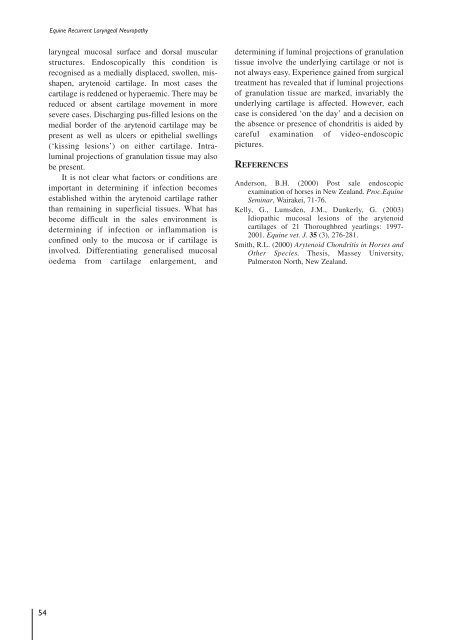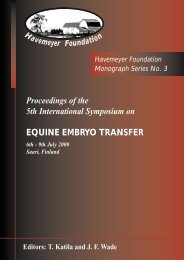Proceedings of a Workshop on - The Havemeyer Foundation
Proceedings of a Workshop on - The Havemeyer Foundation
Proceedings of a Workshop on - The Havemeyer Foundation
Create successful ePaper yourself
Turn your PDF publications into a flip-book with our unique Google optimized e-Paper software.
Equine Recurrent Laryngeal Neuropathy<br />
laryngeal mucosal surface and dorsal muscular<br />
structures. Endoscopically this c<strong>on</strong>diti<strong>on</strong> is<br />
recognised as a medially displaced, swollen, misshapen,<br />
arytenoid cartilage. In most cases the<br />
cartilage is reddened or hyperaemic. <strong>The</strong>re may be<br />
reduced or absent cartilage movement in more<br />
severe cases. Discharging pus-filled lesi<strong>on</strong>s <strong>on</strong> the<br />
medial border <str<strong>on</strong>g>of</str<strong>on</strong>g> the arytenoid cartilage may be<br />
present as well as ulcers or epithelial swellings<br />
(‘kissing lesi<strong>on</strong>s’) <strong>on</strong> either cartilage. Intraluminal<br />
projecti<strong>on</strong>s <str<strong>on</strong>g>of</str<strong>on</strong>g> granulati<strong>on</strong> tissue may also<br />
be present.<br />
It is not clear what factors or c<strong>on</strong>diti<strong>on</strong>s are<br />
important in determining if infecti<strong>on</strong> becomes<br />
established within the arytenoid cartilage rather<br />
than remaining in superficial tissues. What has<br />
become difficult in the sales envir<strong>on</strong>ment is<br />
determining if infecti<strong>on</strong> or inflammati<strong>on</strong> is<br />
c<strong>on</strong>fined <strong>on</strong>ly to the mucosa or if cartilage is<br />
involved. Differentiating generalised mucosal<br />
oedema from cartilage enlargement, and<br />
determining if luminal projecti<strong>on</strong>s <str<strong>on</strong>g>of</str<strong>on</strong>g> granulati<strong>on</strong><br />
tissue involve the underlying cartilage or not is<br />
not always easy. Experience gained from surgical<br />
treatment has revealed that if luminal projecti<strong>on</strong>s<br />
<str<strong>on</strong>g>of</str<strong>on</strong>g> granulati<strong>on</strong> tissue are marked, invariably the<br />
underlying cartilage is affected. However, each<br />
case is c<strong>on</strong>sidered ‘<strong>on</strong> the day’ and a decisi<strong>on</strong> <strong>on</strong><br />
the absence or presence <str<strong>on</strong>g>of</str<strong>on</strong>g> ch<strong>on</strong>dritis is aided by<br />
careful examinati<strong>on</strong> <str<strong>on</strong>g>of</str<strong>on</strong>g> video-endoscopic<br />
pictures.<br />
REFERENCES<br />
Anders<strong>on</strong>, B.H. (2000) Post sale endoscopic<br />
examinati<strong>on</strong> <str<strong>on</strong>g>of</str<strong>on</strong>g> horses in New Zealand. Proc.Equine<br />
Seminar, Wairakei, 71-76.<br />
Kelly, G., Lumsden, J.M., Dunkerly, G. (2003)<br />
Idiopathic mucosal lesi<strong>on</strong>s <str<strong>on</strong>g>of</str<strong>on</strong>g> the arytenoid<br />
cartilages <str<strong>on</strong>g>of</str<strong>on</strong>g> 21 Thoroughbred yearlings: 1997-<br />
2001. Equine vet. J. 35 (3), 276-281.<br />
Smith, R.L. (2000) Arytenoid Ch<strong>on</strong>dritis in Horses and<br />
Other Species. <strong>The</strong>sis, Massey University,<br />
Palmerst<strong>on</strong> North, New Zealand.<br />
54








